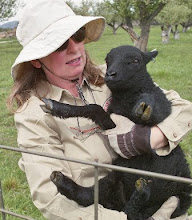
This is a typical carcass of a US line sheep.

First step is breaking the carcass in half.

This is the cross section. This is not a very meaty loin compared to some of our sheep.

We had one lamb show up with a spool joint. This is usually the designation for a mutton. She was only 6 months old. The carcass on the left has a break joint and is a lamb. The carcass on the right has a spool joint and is a mutton.

Frenching the racks.

Trimming all fat off.

Bagging the boneless roasts into netting .

The packages are prepared to be vacuum sealed.

Here they are being packaged by carcass into the boxes.
We learned a lot watching the crew work on our sheep. Our biggest impression is how much fat our sheep have on them. These are entirely grass finished and not fed any grains yet they had more fat cover than I expected to see. I can only imagine how fat they would get if fed grains.
The lamb that had to be marked as mutton was also interesting. Most Black Welsh are slow growing and it is unusual to have one grade out as a mutton when less than a year of age.
The meat cutting and packing crew was 8 people and it took about 20 minutes to fully process one carcass. That is one reason for the high cost of food. A good slaughterhouse has a very skilled set of workers and they spend a lot of time making sure the meat is cut to order. The difference between a small place like this one and a huge assembly line is obvious. The smaller plant cares and every person is skilled and can do most of the jobs. They know how to cut meat to individual orders and are willing to keep individual carcasses separate and tracked for us. A far cry from huge plants where each worker only does a single cut all day.
It's a pleasure to have such a good partner in providing our customers with good meat.




This is interesting; how could I have missed this post?
ReplyDeleteI doubt the average consumer even considers the anatomy that goes into their dinner - and they'd probably be suprised at the lack of gore. Any chance of a larger detail of that spool/break joint comparison photo? I tried to zoom and couldn't see what the difference is.
Is the blood saved out for sausage or for fertilizer? I remember you posting that they're willing to work with sheep who have a full rumen, so do the area farmers use this for fertilizer? Elena
I'll see what I can do about the spool/break joint picture. The spool joint looks like a spool of thread sort of. The break joint is flat.
ReplyDeleteNone of the blood is saved. All the inedible parts go to a rendering plant. It could be composted but there isn't a facility in Western Colorado that can take it and do that properly so it gets shipped to Utah for rendering.
I'll be updating with the killing side but probably no pictures. Even that was not gory in the way most people think it is.
Wonderful post. Stumbled upon your blog. GREAT BLOG!!! Your ranch seems wonderful! Thanks for all you are doing for sustainable HEALTHY food!!!
ReplyDeleteStop by if you'd like. I would love to know more about how you market your lamb.